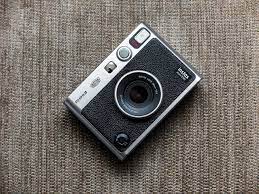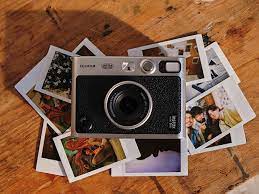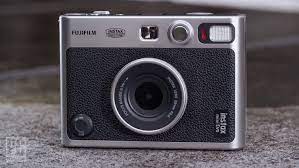So far, our favorite hybrid instant camera is indeed the Fujifilm Instax Mini Evo. Hybrid instant models combine digital photography with instant film inside a single device, making them an excellent introduction to the medium for anybody new to it. Fujifilm’s current attempt is one of the first to appreciate the analogue format’s heritage, despite the fact that they’re not really a new concept.
With a vintage appearance and an array of easy-to-use filters and effects meant to replicate analog film. The Instax Mini Evo is a love letter to Fuji’s heyday in the 1970s. Is it, however, primarily an instant camera or merely a digital camera with an interoperable Instax film printer?
The LCD display and microSD card port point to the latter, which will certainly disappoint instant photography enthusiasts. When a ten-shot package of Instax Mini Evo films costs roughly $8/£8, it’s easy to see the allure of a camera that prints only the photos you choose, rather than every time you push the shutter button. It might be suitable for you if the notion of wasting film while learning the subtleties of analog has originally put you off instant cameras.
Newcomers to the field will appreciate the simple controls and wide range of image effects accessible at the touch of a button. If you prefer to capture simply what the camera lens views, the Fuji Instax Mini LiPlay, which is somewhat less expensive, goes for a more modern look while preserving the hybrid’s picture first, and printing later features.
What we will see here?
Price and availability

The Fujifilm Mini Evo, which costs £174.99/$199.95, is a more costly instant camera. It is available via
At the time of writing, several big stores were out of stock; visit the Instax site for a complete list of merchants that still have the camera in stock.
When selecting an instant camera, you need also consider the expense of film, as you would with any other. In the UK, a package of 20 Instax Mini Evo Instant Film costs roughly £14.99, whereas, in the US, it costs around $18. Other cameras, such as the Polaroid Snap, print on Zink paper. Although this is substantially less expensive at £12.99 on 20 sheets, it is not an actual film.
Considering Instax Mini LiPlay. Which has a Cost of £149.99/$159.99 and is a camera and smartphone printer combo. The shooting functions, on the other hand, are not as handy as those found on the Instax Evo Mini.
Design

The Instax Evo Mini is unquestionably elegant, with a fake leather and chrome design based upon an ancient rangefinder camera. It’s nearly entirely made of plastic, so it shouldn’t feel as high-end as it appears, but it’s reassuringly heavy to carry.
The Mini Evo, like the previous Instax Mini LiPlay, does not reveal its film directly. It has a significantly smaller body than a standard instant camera since it has a digital detector in between the lens and the film. The lens just spreads a little from the main body, making it easy to slip into or out of a bag, but it will only fit into the largest of trouser pockets.
The lens barrel, which can be spun to cycle between lens modes, is surrounded by a power switch, shutter button, and small selfie mirror on the front of the camera.
A second shutter button, a settings shortcut, and even a mode dial specific to enhancements, as well as a cool shoe attachment for attaching accessories, are all on the top of the camera. A lever looking like such an analog film advancement is to print a photo, which is a nice touch. However, just a handful of these keys, leave novices unclear about what to do.
The camera’s hybrid nature is evident by a 3-inch LCD display plus navigation controls on the back. They’re integrated into the film door.
The built-in battery may last up to 100 pictures and approximately 20 photo printouts. It is rechargeable using a micro USB connector just on the bottom of the camera. It also has a microSD card slot. Before you need to add extra storage, the Mini Evo’s built-in storage can hold up to 45 photos.
Features and image quality

The ability to choose from 100 varying configurations of filters as well as color selections is one of the advantages of the Instax Mini Evo over just a normal instant camera. You may also set the flash to automatic or switch it on or off.
This device lacks most of those gimmicky social features seen in Instax’s previous hybrid camera, the LiPlay, and instead concentrates on the essential characteristics of a digital camera. Face detection, an AF illuminator, and other entertaining features like mirror projection and fisheye effects are all in here.
The camera features a 4.9MP resolution and a 28mm focal length. It glows brightest when it is used in direct sunlight. But don’t assume the same level of clarity as you’d find on a smartphone. The light will help with certain low-light shooting, but the Instax Evo Mini will struggle to concentrate on nighttime objects.
While the Instax Mini Evo’s physical buttons and knobs are incredibly user-friendly, its menu interface is a pain to use. Fortunately, due to the plethora of manual controls, One did not have to go into this very much.
The Instax mini Evo prints quite quickly, and the photos it produces have a beautiful retro feel to them. You may print them in either natural or rich mode, which boosts the warmth of the tones. The photographs are approximately the size of something like a credit card and are small enough to fit inside a wallet.
Instax Mini Evo’s Application

The Instax Mini Evo application, which is available on both iOS and Android, is necessary to continuously use the functionality of the Fujifilm Instax Mini Evo camera.
You can print photographs from your collection, transfer images taken in the camera to your smartphone, and activate the remote shooting option to receive a camera stream of what the lens is taking on your phone once you’ve connected the camera with your phone.
The app’s general style is quite user-friendly, although the text should be larger for accessibility purposes, and there appears to become a lot of lost space.
You may also utilize filters, modify the orientation, trim the photographs, and also use color grading tools when printing photos. You must first print photographs taken with the camera before transferring them. If you don’t want to avoid wasting your film unnecessarily, this may be an irritation.
Fujifilm Instax Mini Evo camera has a history of developing several applications for many platforms. It would be much simpler if they just made a single, minimalist app for all of their items.
Conclusion
The Fujifilm Instax Mini Evo camera is our favorite hybrid instant camera so far, with a vintage twist on instant photography that prioritizes enjoyment. With autofocus, autoexposure, and auto shutter speed, it’s significantly more compact than Fuji’s previous Instax cameras, and it’s also more point-and-shoot friendly. Fans of pure analog photography may be afraid of the digital-first approach and absence of an optical viewfinder, and the poor resolution means it won’t be able to replace even just a basic digital camera. However, the Instax Mini Evo‘s ability to function as a smartphone printer is impressive, and its several built-in effects & filters provide a fun opportunity to play without wasting film.
Read more:
- Instax Link Wide – An Easy-To-Use Instant Photo Printer!
- Best Instant Cameras of 2022: Check the top ones!
- Best iPhone photo printer, you can make a picture in an instant
- Hone your creativity and gaming skills with the best MSI laptops in 2025!
- Enhance your entertainment experience with Reavon UBR-X200!
















